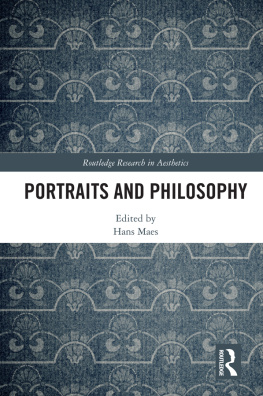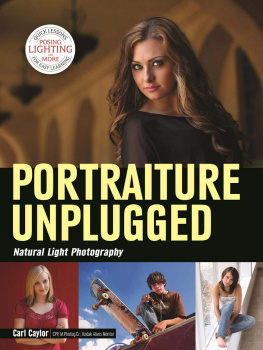Introduction to
Natural Light Photographic Portraiture
Indoors and Out

David Bigwood,LRPS
Published by DavidBigwoodpublishing.com atSmashwords
Copyright 2018 David Bigwood
Smashwords Edition,Licence Notes
This e-book islicensed for your personal enjoyment only. This e-book may not bere-sold or given away to other people. If you would like to sharethis book with another person, please purchase an additional copyfor each recipient. If youre reading this book and did notpurchase it, or it was not purchased for your use only, then pleasereturn to Smashwords.com and purchase your own copy. Thank you forrespecting the hard work of this author.

About the Author
David Bigwoodis a regularly published writer and photographer with his workhaving been used in well over fifty publications, mainly inAustralia and the United Kingdom.
He startedfreelancing in the days of black and white film when he madepictures of his children which sold as 10x8 prints to several UKand Australian magazines.
He hasqualified as a Licentiate of the Royal Photographic Society and isa former member of the Australian Society of Authors.
For three yearshe was a columnist on freelancing for the UK magazine F2Freelance and Digital. He has written a number of articles forAustralian Photography , Australian Camera andBetter Photography.
He founded andedited The Black and White Enthusiast magazine (laterSilvershotz) and was sometime editor of the Journal ofthe Australian Photography Society.
He sells imagesthrough Alamy, the on-line photography library.
Introduction
Making picturesof people had been the province of artists with pencil and paintbefore photography came along. Portraiture then added anothermedium to its bow as photographers made its genre popular from thestart. We have all seen some of the early results from thecomparatively clumsy cameras of the Victorians. We may consider thepictures stiff and excessively formal but at least we have aninkling of how that era was.
Today, makingpictures of people is probably the number one subject for cameraand mobile phones. Sadly most of these pictures may never see thelight of day ending up on a computer or languishing on a phoneuntil a computer crash or a phone malfunction sends them off to theether never to be seen again.
The aim of thise-book is to encourage you to make such worthwhile pictures of yourfriends and family that you will want to preserve the results asprints which will show the people of fifty or a hundred years timewhat we were like in the beginning of the twenty-first century.
I have chosento show pictures that have been made by natural light, both indoorsand out, as I think this light produces some of the bestillumination you can use to get natural portraits as manyprofessional portrait photographers know. And, if it is good enoughfor them, its good enough for me.
Daylight Indoors
This picture of my daughter wasa casual portrait as she leant on our bed one morning. I cantreme mberwhat it was that she wanted but I was so taken by the naturalnessof the pose that I grabbed my camera and captured it.
The soft light was from the windows on theother side of the room with some reflection from the lightbedspread she was leaning on. You can see the catch-light from thewindow in her eyes.
It is one of my favourite pictures of heras a little girl and it would have been almost impossible toduplicate the expression in a studio lit shot.
Another morningin our bedroom. It was becoming quite a studio! I love the softlight provided through the windows which has captured her hairbeautifully. This picture has been used in a UK magazine toillustrate an article on sick children. I hasten to add, she wasperfectly healthy when this picture was made.
Once again itis the naturalness of the pose that makes the picture. The lightwas there, the pose was right and all I had to do was press thecamera button. If I had had to use flash the atmosphere would havebeen lost. And studio lighting would have taken a lot of expertiseto capture the softness of the natural light.
Another portrait softly litfrom a window several feet away from the subject. You can see thecatch-light from the window in her eyes.
In theoriginal negative the eye was distracted from the sitter becausethe background wallpaper and cushion were too sharp (should haveused a wider aperture!) but post processing in Photoshop hasenabled me to blur the offending background and so reduce itseffect.
One of thegreat benefits of using natural light is that the sitter does nothave a feeling of being overpowered by studio lights glaring ather. This is especially true with non-professional models.
The softness ofthe light from the window directly opposite the sitter has made thepicture suitable for the vignetting that I have applied in postprocessing. The window had venetian blinds which enabled me to havesome control over the amount of light falling on the subject.
These blindsare just one of the controls I have when shooting with naturallight. Others include a sheet of white cardboard to bounce somereflected light onto the shadow side of a face and the applicationof greaseproof paper to a window if the light is too bright.
On thisoccasion the windows were so placed that I was able to include themin the picture while allowing the natural light to illuminate themodel.
Under normalcircumstances the light would have probably been too strong toenable the making of a suitable picture but on this day theovercast sky produced the soft light that works so well withportraiture.

Portraitureneed not be just a picture of an individual. Sometimes the story ofthat individual is better told by including something of theirenvironment. In this case the old lady is surrounded by the thingsthat help to make her life comfortable.
I think thecontre jour treatment and the black and white picture tells thestory well. The shot was made without disturbing her morningroutine. No bright flash and certainly no studio lights if I hadeven suggested that I was about to make a picture she would havebeen horrified! So, natural light to the rescue and a quietly madepicture enables me to remember something of the last years of mymothers life.
Next page














